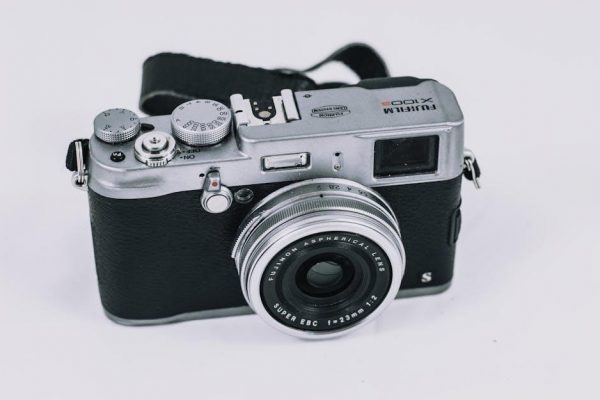Polaroid Snap Camera⁚ A Comprehensive Guide
This comprehensive guide provides a detailed walkthrough of the Polaroid Snap instant print digital camera. Learn about its features, operation, and maintenance, ensuring you capture and cherish memories effortlessly. From unboxing to troubleshooting, this manual covers everything you need to know.
Unboxing and Initial Setup
Carefully unpack your new Polaroid Snap instant camera. Inside the box, you’ll find the camera itself, a micro USB cable for charging, and potentially a wrist strap. Check the contents against the included packing list to ensure everything is present. Before powering on, locate the micro SD card slot (if your model includes one) and insert a compatible card for storing digital copies of your photos, if desired. Familiarize yourself with the camera’s exterior – locate the power button, shutter button, and any other controls. The included user manual provides a detailed overview of each component and its function, helping you understand the layout before proceeding.
Next, charge the camera fully using the supplied micro USB cable and a suitable power adapter. The charging process is usually indicated by an LED light, which changes color or pattern when fully charged. Consult your specific camera’s manual for precise charging instructions. Once the camera is fully charged, you’re ready to begin taking photos. Remember to read the safety precautions and warnings in your manual prior to operation to ensure safe and optimal use of your new Polaroid Snap camera.
Getting to Know Your Polaroid Snap
The Polaroid Snap boasts a user-friendly design. Its compact size and lightweight construction make it ideal for portability. The front features the lens, flash, and sometimes, a small LCD screen (depending on the model). On the back, you’ll find the power button, usually integrated into the viewfinder. Opening the viewfinder activates the camera. The top might house additional buttons, such as a self-timer button or flash override. The placement of the buttons and controls might vary slightly depending on the specific Polaroid Snap model.
Locate the print slot where you’ll insert the Polaroid Zink photo paper. On the side or bottom, you’ll find the micro USB port for charging and potentially a microSD card slot for storing digital images. Many models include a wrist strap attachment point for added security. Familiarize yourself with the camera’s physical aspects and button functions. Understanding the camera’s layout ensures smooth operation. Different models might have slight variations in design and button placement; always refer to your specific model’s user manual for precise details regarding button functionality and placement.
Powering On and Off
Switching on your Polaroid Snap is straightforward. Locate the power button; its position varies slightly depending on the model, but it’s often integrated into the viewfinder mechanism. Gently press the power button. The viewfinder will typically pop open, indicating the camera is powering up. A short delay might follow before the camera is fully ready to capture images. The camera might also emit a subtle sound or display a brief startup sequence on the screen (if equipped).
To power off your Polaroid Snap, the process is equally simple. While the methods vary slightly across models, generally, you’ll need to close the viewfinder completely. This action typically triggers the power-off sequence. Some models might offer a dedicated power-off button, but closing the viewfinder remains a common method across many Polaroid Snap cameras. Always ensure the camera is fully powered down before disconnecting the USB cable or changing the battery (if applicable).
Note that the Polaroid Snap enters a sleep mode after a period of inactivity to conserve battery life. Simply opening the viewfinder again will reactivate the camera.
Taking Photos⁚ Basic Operation
Taking photos with the Polaroid Snap is incredibly intuitive. Compose your shot using the viewfinder or LCD screen (if your model has one). Ensure your subject is well-lit and properly framed within the viewfinder. The camera automatically focuses, simplifying the process. Once you’ve composed your shot, gently press the shutter button. The camera will automatically capture the image and initiate the printing process (if you’re using Polaroid ZINK paper); The camera’s flash will fire automatically, unless you’ve disabled it, ensuring a well-lit image even in low light conditions.
For best results, avoid taking pictures in extremely low light conditions without the flash enabled. The flash is essential for well-exposed images. If using the self-timer, remember to press the self-timer button before pressing the shutter button. The precise location of the shutter button might differ slightly depending on the specific Polaroid Snap model, but it’s usually easily identifiable. Experiment with different compositions and lighting to master your Polaroid Snap photography skills. Remember to insert photo paper before taking photos to ensure immediate prints.
Understanding the Flash
The Polaroid Snap camera incorporates a built-in flash that automatically activates with each photo. This flash is crucial for capturing well-lit images, especially in low-light or dimly lit environments. The flash’s intensity is automatically adjusted by the camera to ensure optimal exposure. While the flash is generally beneficial, there might be situations where you might want to disable it. For instance, if you’re shooting in bright sunlight or prefer a slightly different aesthetic, you can override the automatic flash setting. However, remember that disabling the flash in low-light situations will likely result in underexposed and potentially blurry images.
The method for disabling the flash might vary slightly depending on your specific Polaroid Snap model; consult your camera’s manual for precise instructions. In most cases, there’s a dedicated button or setting to control flash operation. Typically, a small button or icon on the camera’s body allows you to override the default automatic flash. Experiment with using the flash and disabling it in different lighting conditions to better understand its impact on your photographs. Remember, in low light, the flash is highly recommended for sharp and well-exposed photos.
Utilizing the Self-Timer
The Polaroid Snap camera features a convenient self-timer function, perfect for capturing group photos or selfies where everyone can be included in the frame. This ten-second self-timer provides ample time for you and your subjects to get into position and ready for the shot. To activate the self-timer, locate the designated timer button on the top of the camera. Press this button once to engage the self-timer mode. The camera will indicate that the self-timer is active, usually through a visual cue on the screen or a light indicator. Once the self-timer is activated, compose your shot and get ready.
After you’ve framed your photograph to your liking, press the shutter button to initiate the countdown. The camera will begin its ten-second countdown, giving you sufficient time to get into the desired position and strike a pose. At the end of the ten-second countdown, the camera will automatically take the picture. Remember to maintain a stable position during the countdown to prevent blurry images; The self-timer is a valuable tool for capturing memorable moments with ease and ensuring everyone is present in the photograph. Experiment with different angles and compositions to maximize the creative potential of this feature.
Inserting and Refilling Photo Paper
The Polaroid Snap utilizes Zink photo paper, a unique paper type that doesn’t require ink cartridges. To insert the paper, locate the designated paper slot, usually clearly marked on the back or side of the camera. Gently open the paper slot, ensuring you don’t force it. Insert the Zink photo paper stack, making sure the paper is aligned correctly according to the camera’s instructions. The camera will usually indicate the correct orientation of the paper. Close the paper slot firmly, ensuring the paper is securely in place. The camera will automatically detect the paper and be ready to print.
Refilling the paper is equally straightforward. Once the camera signals that the paper is low or empty, follow the same steps as for initial insertion. Remove the remaining paper (if any), and insert a fresh stack of Zink paper. Always use Polaroid-branded Zink paper for optimal results. Using alternative brands may result in printing issues or lower image quality. It’s important to handle the paper carefully to avoid smudging or damaging the prints. Store unused Zink paper in a cool, dry place to maintain its quality and prevent issues with printing.
Using the SD Card for Storage
Enhance your Polaroid Snap experience by utilizing the SD card slot for additional image storage. The SD card allows you to save digital copies of your photos beyond the instant prints. This is particularly useful for preserving high-resolution images or for situations where you might prefer to print only select photos later. To insert an SD card, locate the SD card slot, typically on the side or back of the camera. Gently insert the card, ensuring it’s correctly aligned with the slot. The camera should automatically recognize the card.
The Polaroid Snap supports SD cards with a maximum capacity of 32GB (check your specific camera’s manual for exact specifications). Using a larger capacity card allows you to store a greater number of high-resolution images. Remember to format the SD card using the camera’s settings to ensure compatibility and optimal performance. Once the SD card is inserted and recognized, you can choose to save your images to both the SD card and print instantly, or only to the SD card, saving the instant print function for your favorite shots. Regularly back up the contents of your SD card to prevent data loss.
Connecting to a Smartphone (if applicable)
While the Polaroid Snap’s primary function is instant printing, some models offer smartphone connectivity for enhanced functionality. This typically involves using a dedicated mobile app, which you’ll need to download from your app store (iOS or Android). Once downloaded and installed, ensure your smartphone’s Bluetooth is activated. On your Polaroid Snap, locate the Bluetooth pairing option within the camera’s settings menu; this might be represented by a Bluetooth icon or a similar indicator. Consult your camera’s user manual for precise instructions.
After activating Bluetooth on both your camera and phone, initiate the pairing process through the app. The app will likely guide you through a series of steps to establish a connection with your Polaroid Snap. Once paired successfully, you can utilize the app’s features, which might include remotely controlling the camera, viewing images stored on the camera’s SD card, or even applying filters or editing functions directly to your photos before printing; Remember that app availability and functionality may vary depending on your specific Polaroid Snap model.
Troubleshooting Common Issues
Troubleshooting Common Issues
Encountering problems with your Polaroid Snap? Let’s address some common issues. If your camera isn’t powering on, ensure it’s adequately charged. Check the battery indicator or try using a different power source. If images are blurry, verify the lens is clean and free of smudges. Ensure sufficient lighting; the flash may need to be enabled in low-light conditions, but remember to disable it if natural light is ample to avoid overexposure. If prints are faint or lack vibrancy, try using fresh Polaroid ZINK paper; old or improperly stored paper can yield subpar results.
Should the camera freeze or become unresponsive, attempting a soft reset is recommended. This usually involves holding down the power button for a prolonged period (consult your manual for the exact duration). If a memory card error occurs, ensure the SD card is properly inserted and formatted correctly. If problems persist after trying these basic troubleshooting steps, consult the detailed troubleshooting section within your Polaroid Snap’s user manual, or visit the Polaroid support website for further assistance. They may have updated firmware or more in-depth guides to help resolve specific issues.
Battery Care and Charging
Proper battery care is crucial for optimal Polaroid Snap performance and longevity. Always use the provided USB cable and a suitable power adapter (ideally a 1-amp charger) to avoid damaging the battery. Avoid using fast chargers or power sources exceeding the recommended amperage. Before initial use, fully charge the battery for several hours to ensure optimal functionality. During extended use, the camera may feel warm; this is normal operation, but prolonged exposure to excessive heat should be avoided.
To conserve battery life, turn off the camera when not in use. The camera has an auto-sleep feature that activates after a period of inactivity; this helps prolong battery life significantly. Avoid extreme temperatures—both hot and cold—as they can negatively impact battery performance and lifespan. If you notice a significant decrease in battery life, try a full charge cycle followed by a period of complete discharge (though this is not always necessary). Regularly check the battery level indicator to prevent sudden power loss during important moments. If battery issues persist despite following these guidelines, consider contacting Polaroid support for further assistance or battery replacement if necessary.
Camera Specifications and Features
The Polaroid Snap boasts a user-friendly design coupled with essential features for capturing and printing memorable moments. Key specifications include approximately 10-megapixel image resolution, enabling crisp and detailed photographs. The camera’s image sensor captures photos in a convenient 50.8 x 76.2 millimeter print size, perfect for classic Polaroid aesthetics. Built-in functionalities such as a self-timer and flash contribute to versatility in diverse shooting scenarios. The integrated printer uses ZINK paper, offering a quick and easy way to produce physical prints directly from your camera. Storage options include an SD card slot, allowing you to save digital copies of your images for later access and sharing. The camera’s compact and lightweight design ensures portability for on-the-go photography, making it ideal for spontaneous snapshots and events.
The Polaroid Snap’s intuitive interface requires minimal technical expertise, making it accessible to photographers of all skill levels. Additional features may include various color modes or filters (depending on the model), adding creative flexibility to your photographic journey. While not a professional-grade camera, the Polaroid Snap delivers a fun and straightforward approach to instant photography, perfectly blending classic charm with modern digital convenience. Consult the included user manual or the Polaroid website for specific details on your camera model’s features and functionalities.
Safety Precautions and Maintenance
Safety Precautions and Maintenance
To ensure the longevity and optimal performance of your Polaroid Snap camera, adhere to these safety precautions and maintenance guidelines. Avoid using the camera in excessively humid, dusty, or smoky environments, as these conditions may cause damage or malfunction. Never attempt to disassemble the camera or remove the battery yourself; the battery is not designed for user removal or external charging. During extended use, the camera may become warm to the touch—this is normal operation. However, avoid covering the camera with cloth or blankets, which could impede ventilation and lead to overheating. Always use the camera in a well-ventilated area. Keep the lens clean and free from smudges or dust using a soft, lint-free cloth.
Handle the camera with care to avoid drops or impacts that could damage its internal components. Store the camera in a cool, dry place when not in use. Use only approved accessories and charging cables to prevent damage to the device. Regularly check the SD card for available storage space; a red LED indicator typically signals low storage. For optimal image quality, use only recommended Polaroid ZINK paper. Properly dispose of used photo paper according to local regulations. Refer to the complete user manual for detailed instructions and additional safety information specific to your camera model. By following these guidelines, you can ensure your Polaroid Snap camera provides years of enjoyable and reliable instant photography.


